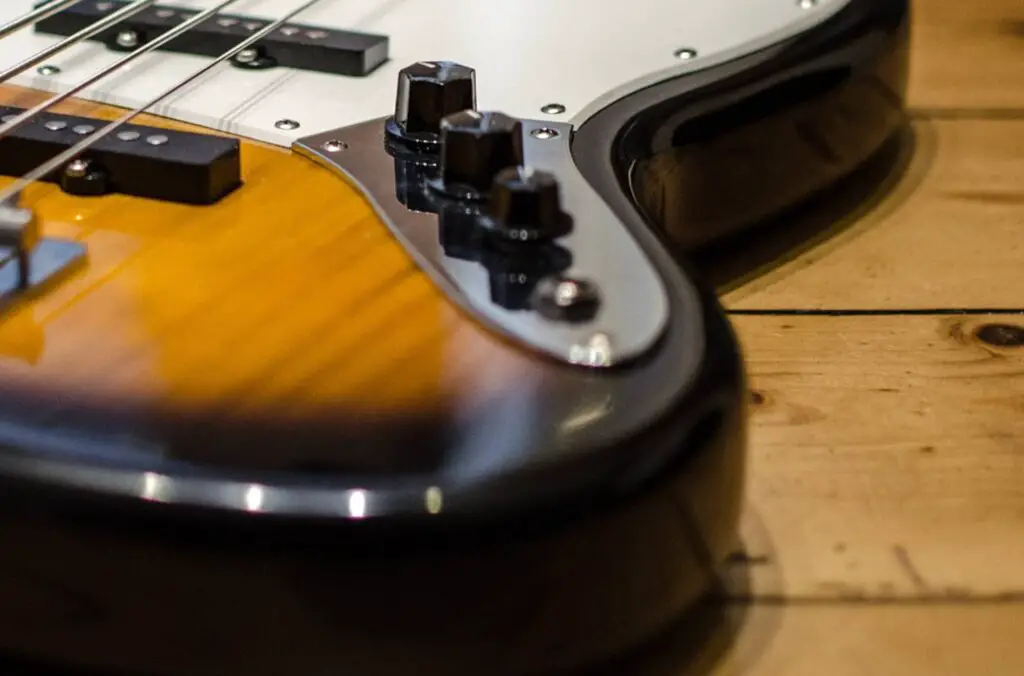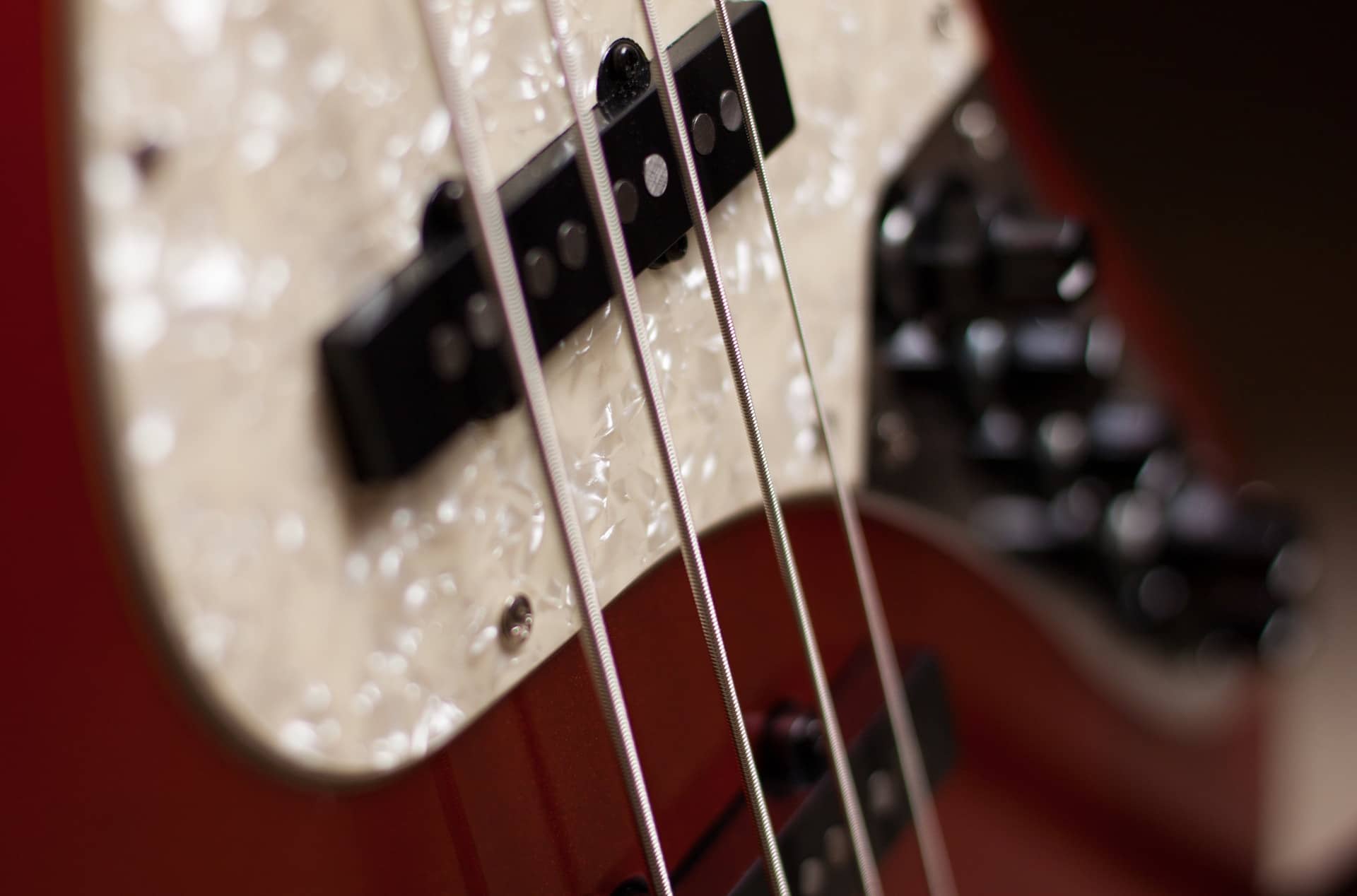The Fender Jazz and the Fender Precision are among the most common basses out there. Both have an iconic tone that has defined how we expect the bass guitar to sound like. But what if you own one and want the sound of the other, and how do you make a jazz bass sound like a Precision bass?
The Jazz bass will never sound identical to the P bass, but it is possible to get a tone that closely resembles it. To achieve this, turn the bridge pickup all the way up, and the tone knob and bridge pickup slightly below 50%. The tone will resemble that of a P bass even more if you pluck strings close to the neck and install a series switch.
Pickup choice, knob usage, plucking style, amp EQ will all impact your tone. Thus, if you are looking to get a good P bass sound out of a J bass, it can be hard to know where to start.
Therefore, I’ve written this article to showcase how close the Jazz bass can get to a Precision sound. You will learn where to begin, and how to customize the tone to get the type of P bass sound you want.
Can a jazz bass sound like a P bass?
A jazz bass can emulate the sound of a P bass to some extent. While it is possible to get a sound that resembles that of a P bass, it will not sound identical.
When the jazz bass was released in 1960, Leo Fender thought it would appeal more to Jazz musicians than the P bass did. Despite this, the jazz bass has seen use in a multitude of genres, such as pop, rock, funk, and soul. While it can produce a tone that is fitting for jazz, it is an incredibly versatile instrument.
In my opinion, you can get a tone that is close enough to a P bass tone. The jazz bass can thus be used for liveshows and recordings where you would otherwise want a P bass. It will be able to do job of a P bass, and the majority of listeners will not be able to tell the difference.
Asking a bassist who has a great ear for different tones, might net you a different answer. You will likely be told that a Jazz bass cannot sound like a P bass and that the J and P bass are different instruments with fundamentally different tones.
This is true. However, how big of a deal the difference in sound is, varies from person to person. If you are a beginner-level bassist or don’t mind small differences in tone, you can get a sound out of the Jazz bass that will feel close enough to that of the P bass.

How do you get P bass tone from jazz bass?
In order to get a P Bass tone from a jazz bass, turn the neck pickup all the way up, and turn the bridge pickup and tone knob to around 40%. Place your plucking hand closer to the neck when playing. Lastly, turn up the bass(low-end) on your amp, and turn down the treble(high-end).
When bassists say they are looking for a “P bass sound”, they never mean exactly the same. Thus, getting a P bass tone out of the jazz bass has some set-in-stone steps, but also requires a bit of experimentation.
The first thing you have to do is to turn the neck pickup all the way up. This pickup has a warmer and thicker tone than the bridge pickup. Thus, it will produce a tone that is much more resemblant to the P bass.
Note: The jazz bass uses humbucking pickups. This means that you might experience a more noticeable hum, when turning one pickup all the way up, and muting the other. You can learn more about how to stop your bass from humming here.
As for the bridge pickup and tone knob, turn them to slightly below half way up. It is at this stage you should experiment with both of these to get the type of sound you are looking for.
Start with both the tone knob and bridge pickup turned all the way down. Then, slowly try turning both of them up. You might get the type of tone you are looking for with the bridge pickup at 20%, and the tone at 50%, or with both at 30%, so go ahead and experiment.
The same goes for amp settings. You want a lot of low-end, and a little high-end. Start with the treble turned all the way down, and the bass turned all the way up, and adjust them till you have a sound that resembles what you consider a P bass sound.
Series Switch
If you want to go the extra mile in making your jazz bass sound like a P bass, you can install a series switch.
Series switches look like this and allow you to switch the pickups in your jazz bass from parallel to series. After installation, it allows you to switch between parallel and series, and thus only gives you more tonal options.
A series switch makes the output of one of your pickups feed into the input of the other. This results in a brawnier and fatter sound. On the jazz bass this produces a sound that more closely resembles that of a P bass.
You can solder the switch onto your bass yourself. When purchasing a series switch you generally also receive a manual on how to instal it.
I recommend seeing how close you can get to a desirable P bass sound with pickup choice and EQ first. If you are unable to get a tone that is close enough to the P bass this way, the next step is to add a series switch to your bass.
Conclusion
The Jazz bass will never be a precision bass. Whether you are able to get a tone on the J bass that is close enough to that of a P bass, largely depends on how picky you are. It also depends on whether you are willing to install a series switch if need be.
The knobs on your bass and your amp will get you most of the way there. As long as you mainly use the neck pickup and don’t have the tone or bridge pickup dialed too high up, you will be well on your way.
It will take some experimenting to find the exact type of tone you are looking for as only you know exactly what you associate with a P bass sound. However, by following the steps outlined above you will know where to start, and how to start customizing the tone.
Unsure about how to enable different pickups? Proceed by reading about what the knobs on your bass do here.

